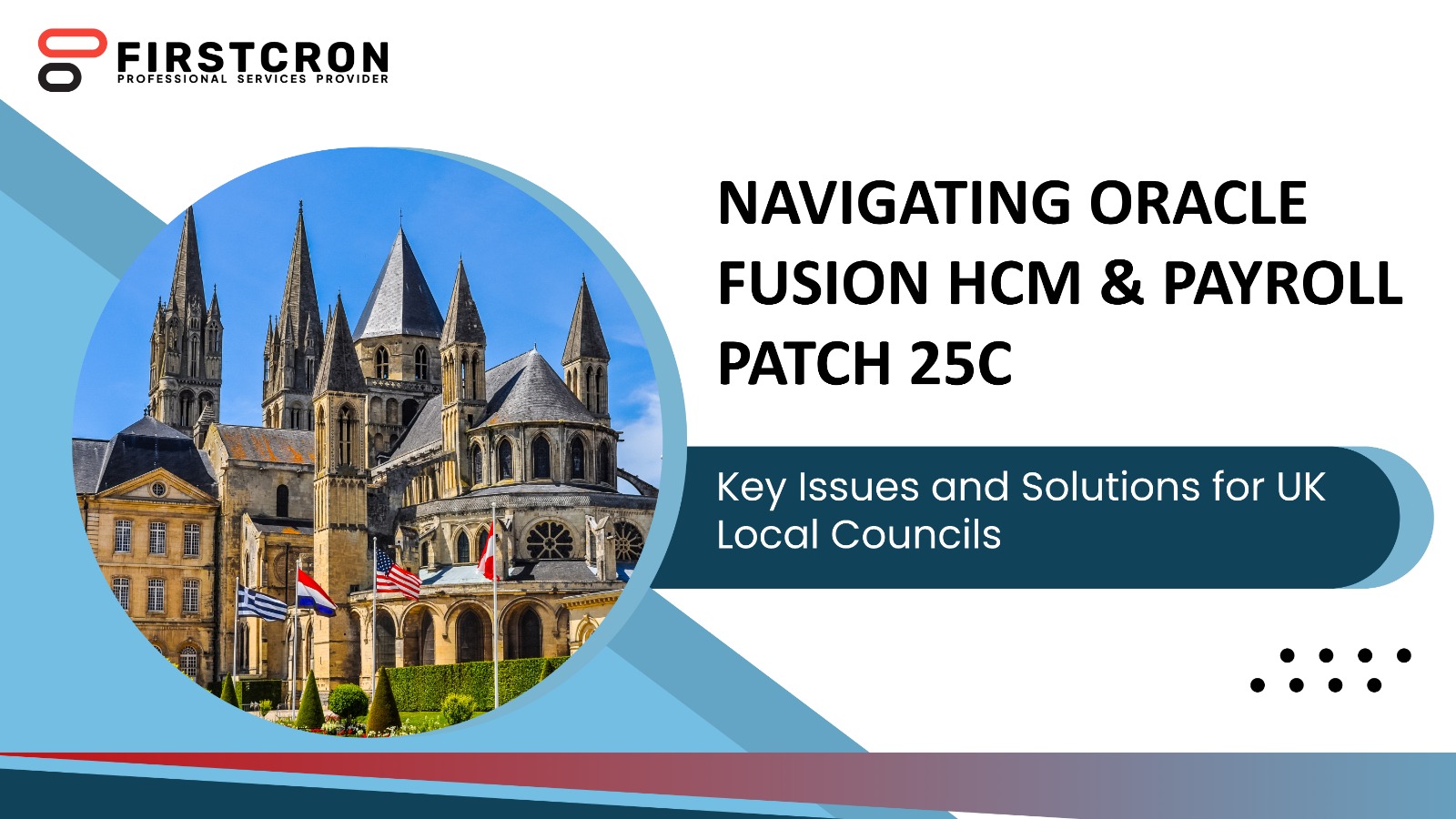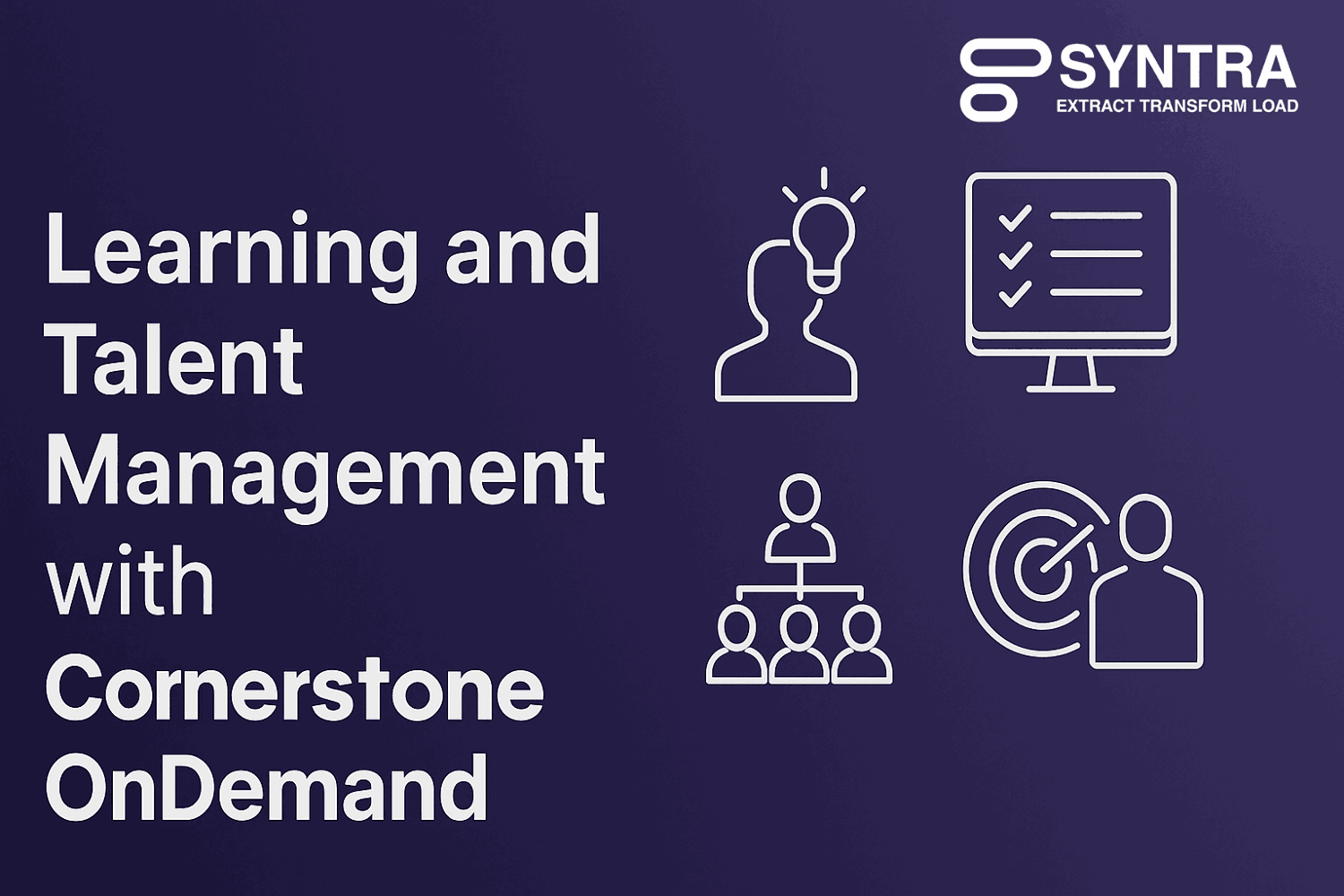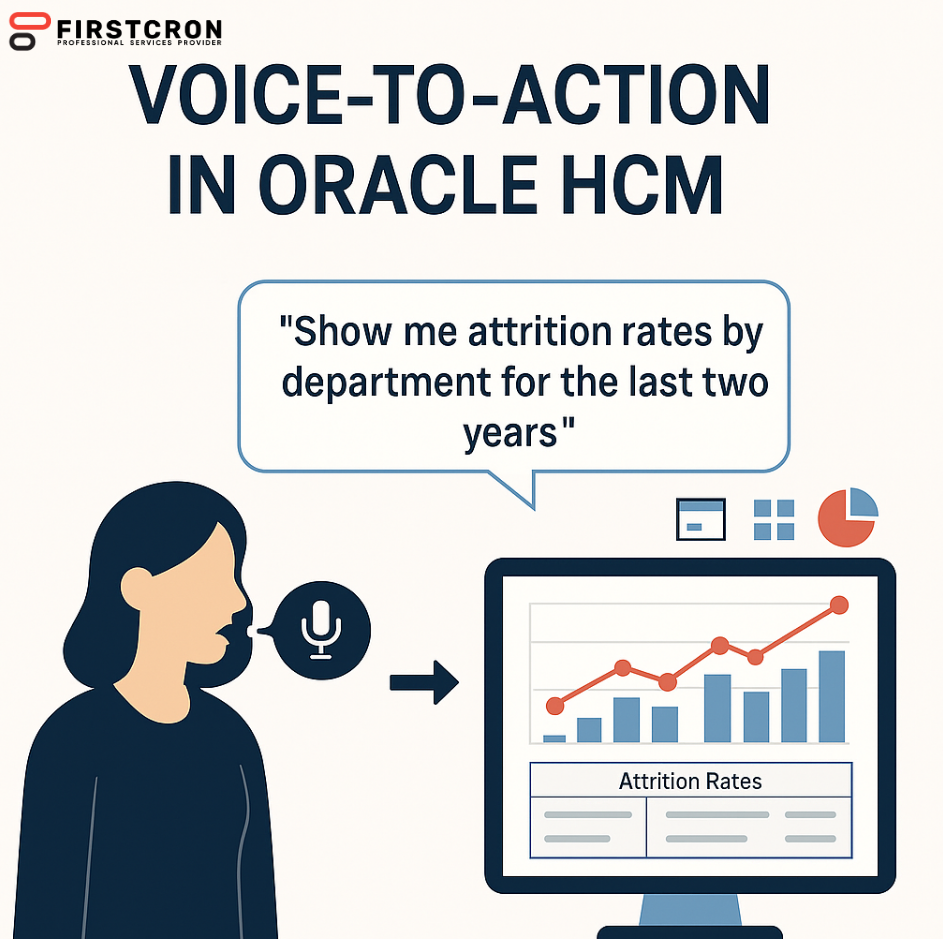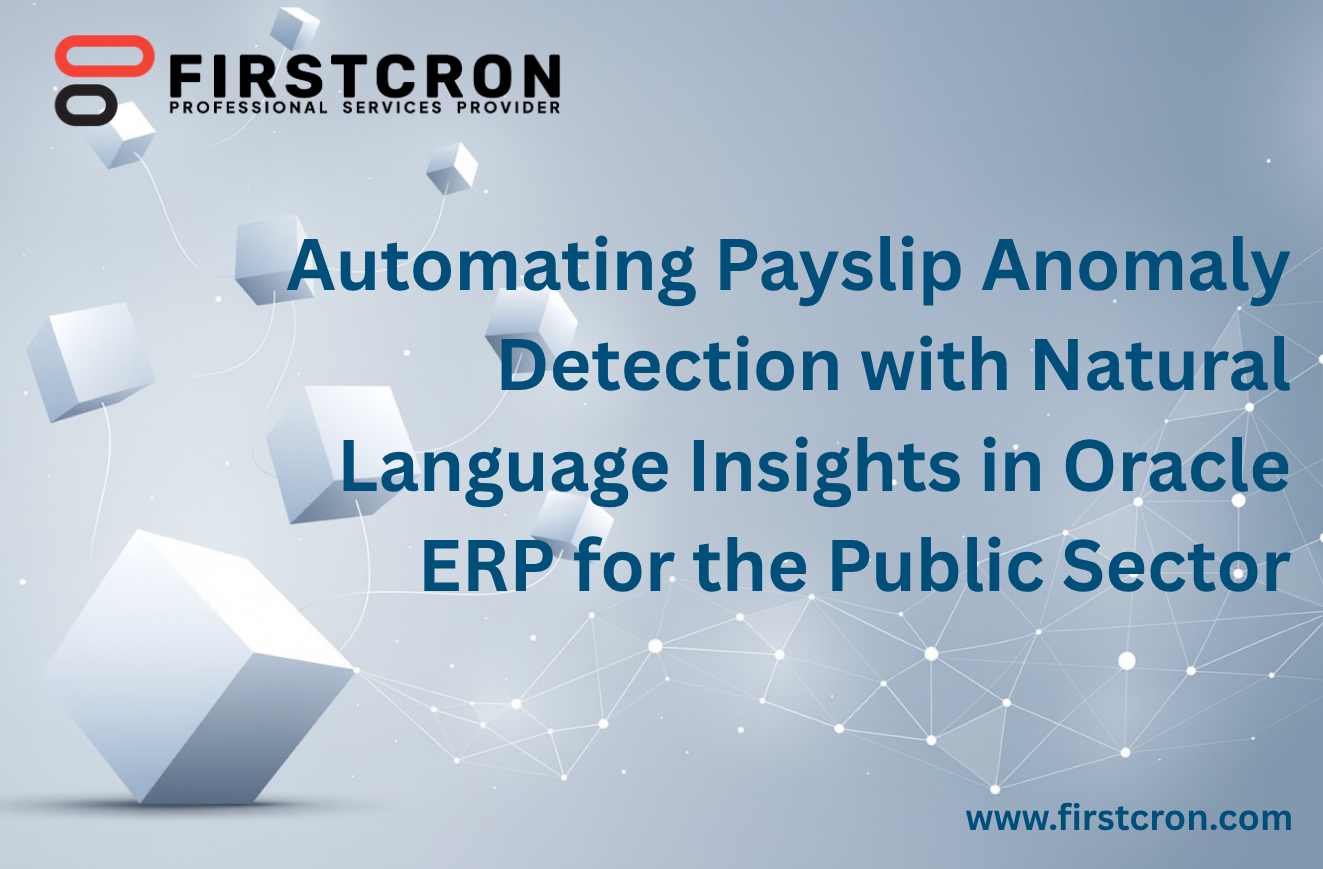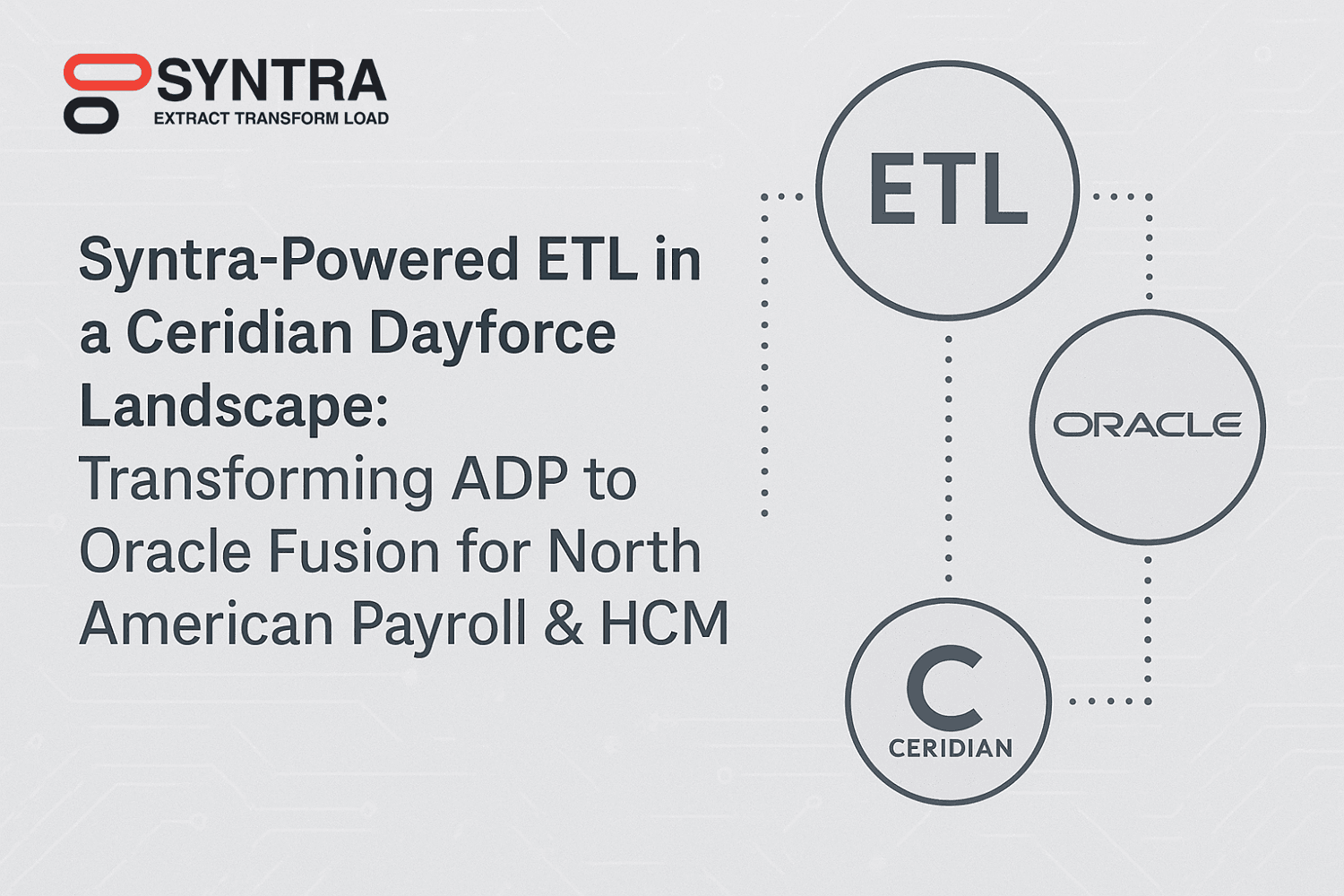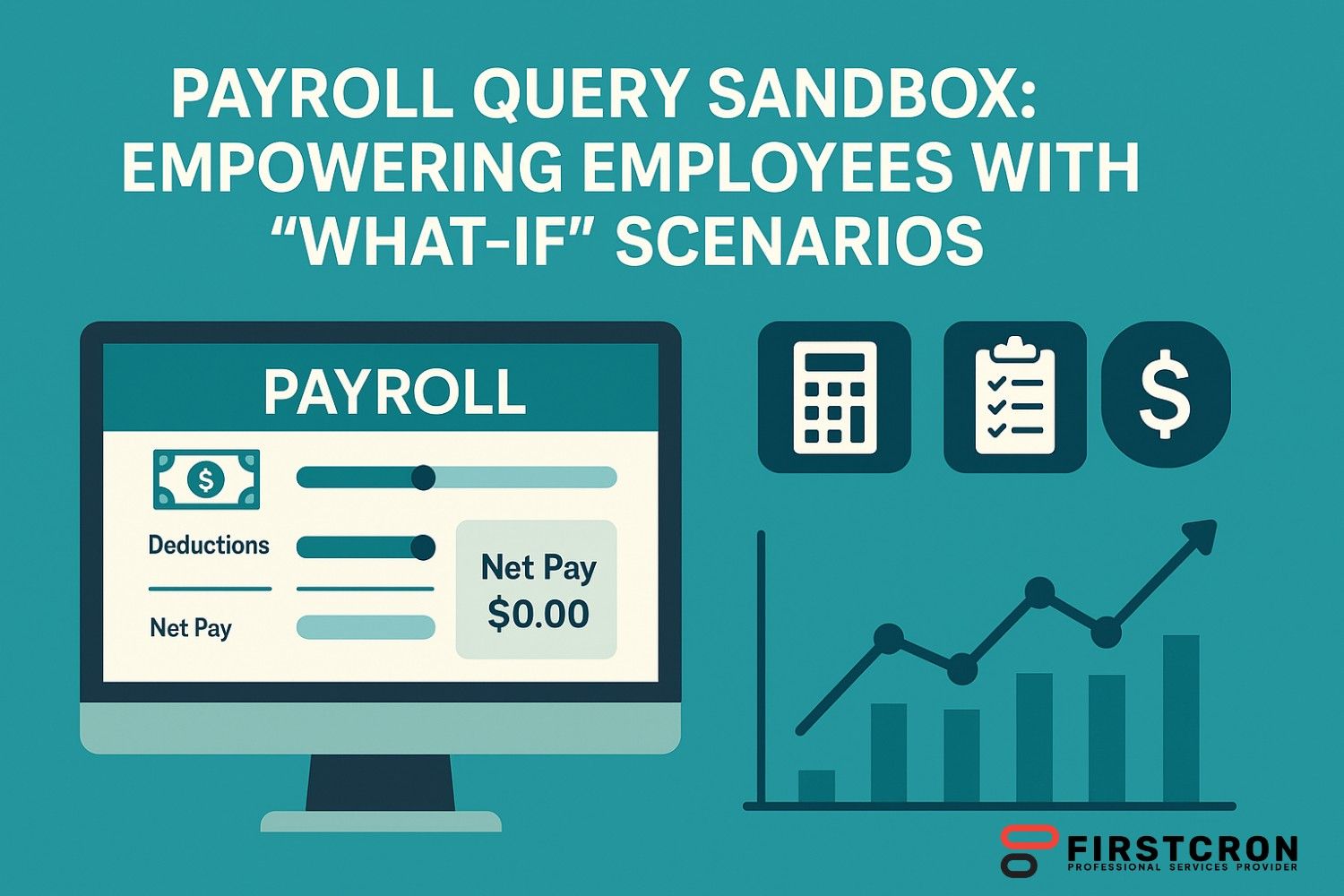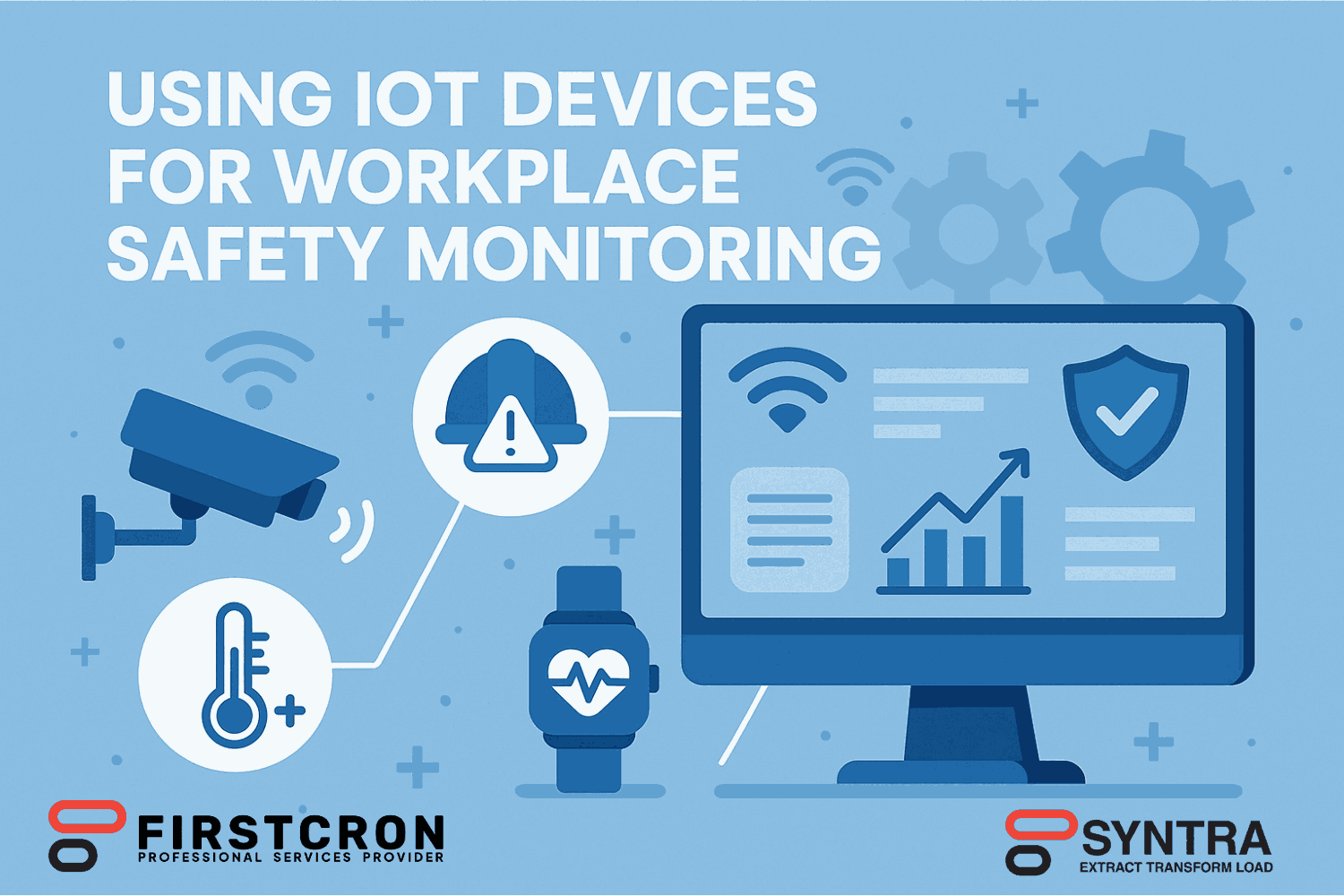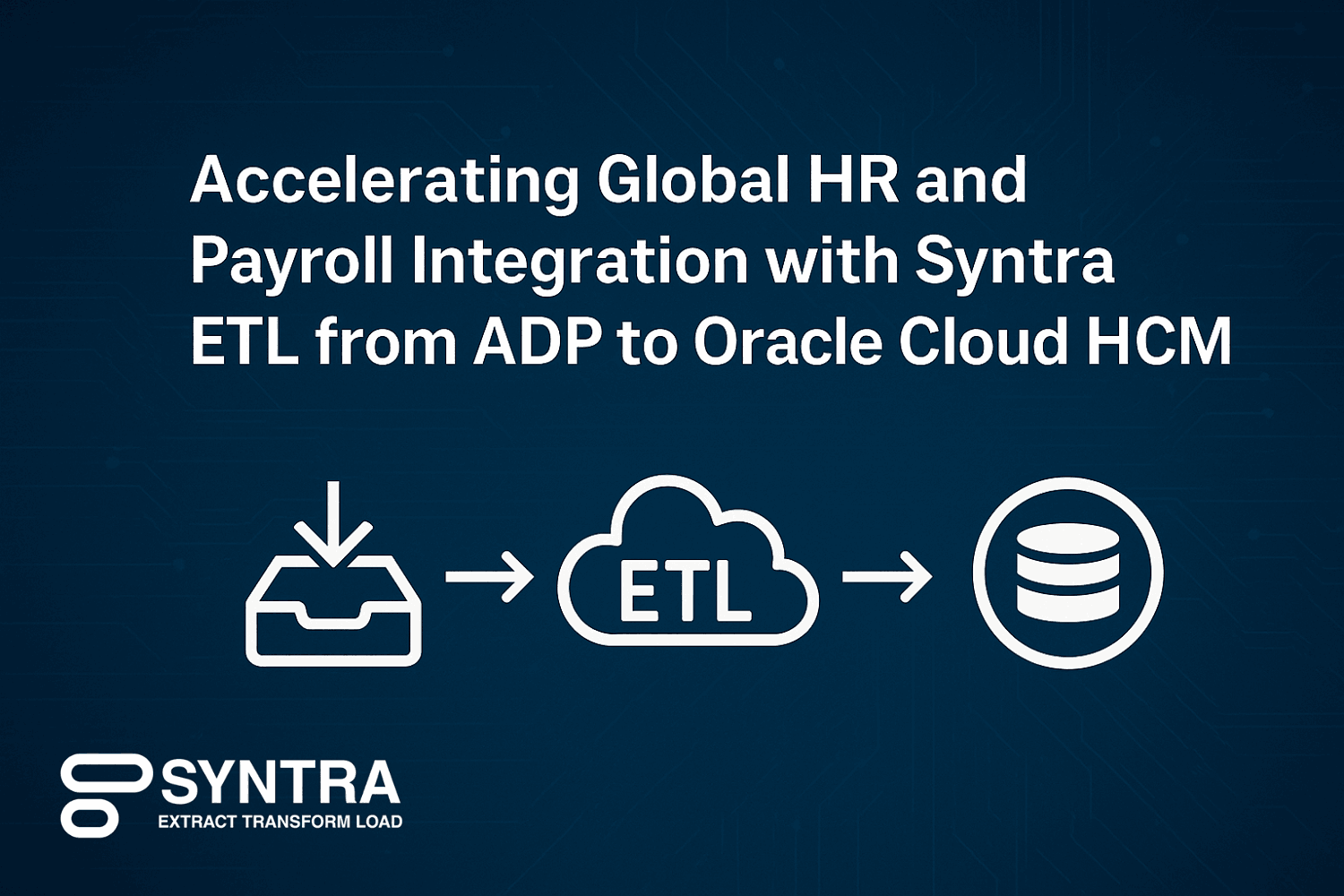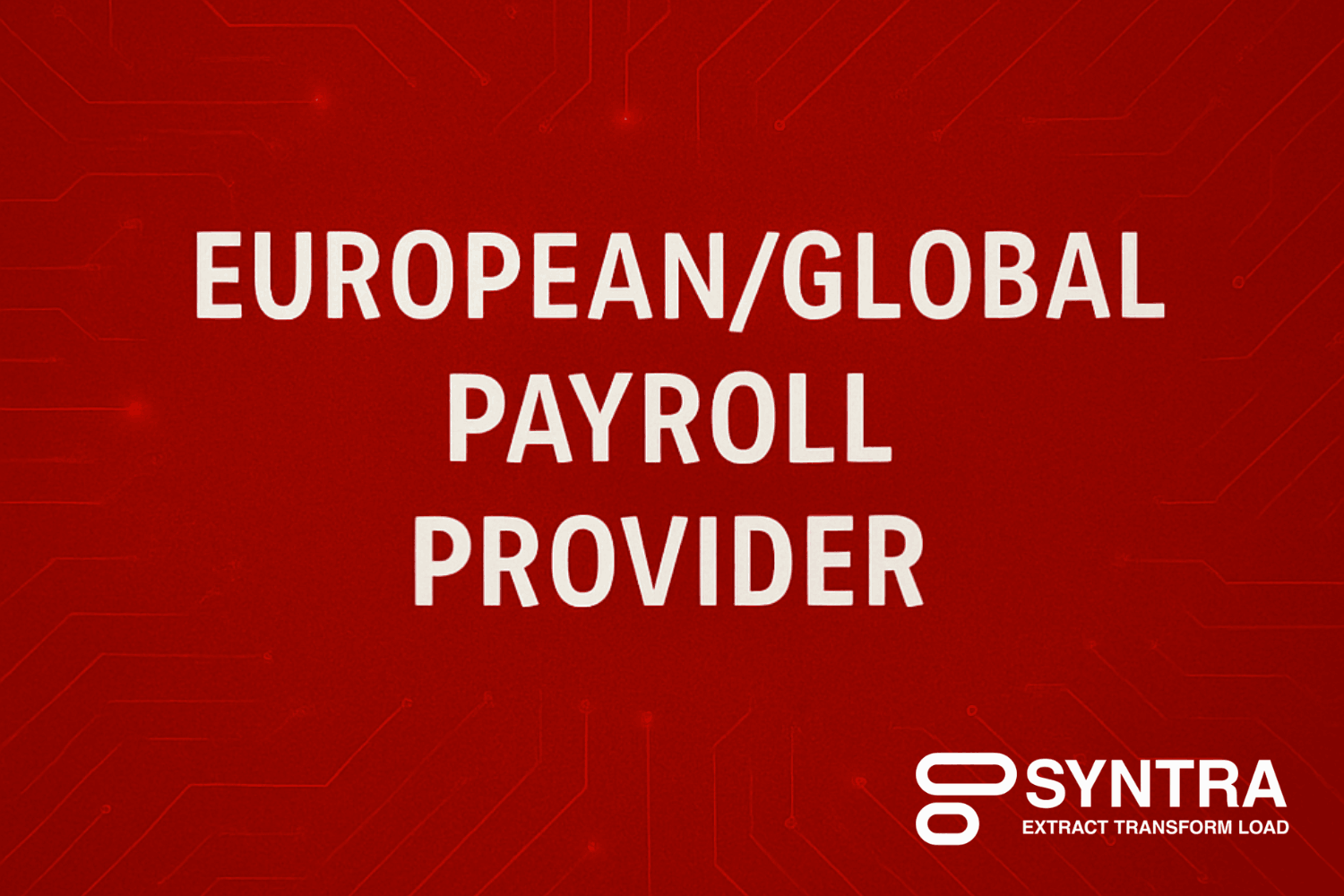
Moving HR and payroll data between platforms sounds simple until you try to run payroll for multiple countries on a tight calendar. ADP exports rarely line up one-to-one with Oracle Fusion HCM’s object model, and manual cleanup—renaming columns, remapping codes, sequencing loads—burns hours and still invites errors. Syntra tackles this exact gap with a governed extract–transform–load (ETL) framework that lifts data out of ADP and reshapes it precisely for Oracle Fusion, so files load cleanly and payroll stays on schedule. Recent briefs describe Syntra as purpose-built for Core HR and payroll movement from ADP to Oracle Fusion, emphasizing accuracy, control, and reduced manual rework.
In this blog we’ll cover
- What Syntra Actually Does
- The High-value Objects That Benefit Most From Transformation
- Why This Matters For European And Multi-country Operations
- Governance, Sequencing, And Error Resilience
- Typical Transformations That Cut Hours From Every Cycle
- Built For Complex, Mixed Application Landscapes
- Compliance And Auditability As First-class Outcomes
- The Business Case: Time Saved, Errors Avoided, Confidence Gained
- Getting Started
What Syntra Actually Does
Syntra automates three things your team otherwise does by hand. First, it standardizes the extraction from ADP—whether you’re pulling master data, time entries, or payroll results—so inputs are consistent. Second, it transforms those inputs into the structure and codes Oracle Fusion expects, applying validation rules and format checks that prevent downstream load failures. Third, it loads through Oracle-friendly mechanisms in the right order, giving you observability into what passed, what failed, and why. That combination moves the process from brittle spreadsheets to a repeatable pipeline aligned with Oracle’s object definitions.
The High-value Objects That Benefit Most From Transformation
The biggest time savings come from the domains where ADP’s semantics differ from Oracle’s. Employee master data is a prime example: person numbers, assignments, jobs, grades, and locations often require normalization, defaulting, or crosswalks to meet Oracle’s constraints. Syntra’s mapping layer aligns these structures so that person and assignment loads don’t stall because of missing or malformed attributes. Similar treatment applies to organizational objects—legal employers, business units, departments, and locations—where ADP codes must be reconciled with Oracle reference data to keep costing and security roles intact once live.
A second high-value area is earnings, deductions, and elements. ADP earnings codes rarely match Oracle element names or input value structures. Syntra centralizes those crosswalks, converts units and amounts as needed, and sequences loads to respect element eligibility and configuration. For organizations that manage allowances, overtime, bonuses, and variable pay, this is the difference between a one-click load and hours of error chasing.
Third, costing is a notorious time sink. Oracle requires complete costing segment combinations; ADP extracts may carry partial or differently structured costing information. Syntra assembles full segment strings, applies defaulting rules, and validates combinations against Oracle’s chart of accounts so journals post cleanly. This prevents the post-payroll scramble to fix suspense postings and reprocess results.
Fourth, taxation and statutory data vary dramatically across jurisdictions. In the US, for example, federal, state, and local tax setups—and garnishments—must be translated into Oracle’s tax model and balanced for each pay period. Syntra’s rules help reconcile these objects so that tax submissions and compliance processes remain uninterrupted. The same pattern extends globally to country-specific attributes, where Syntra’s ETL scaffolding reduces the risk of late filings and penalties.
Finally, time and attendance transactions drive many earnings calculations. Syntra’s transformations validate time codes, roundings, and accrual impacts before loading, ensuring that downstream payroll calculations recognize the right hours, rates, and absence balances. This is especially important when multiple time sources feed the same Fusion environment.
Why This Matters For European And Multi-country Operations
European payroll adds layers—GDPR obligations, multi-currency, collective agreements, and country-specific calculations—that strain generic integrations. Oracle’s own ecosystem acknowledges the need for robust, real-time connections with third-party payrolls to keep accuracy, timeliness, and compliance intact. Syntra complements this by focusing on the transformation layer: aligning country-level constructs such as earning/deduction categories, bank formats (e.g., IBAN), taxation keys, and localized address standards to what Oracle Fusion actually accepts. The result is a repeatable pattern you can use as you expand to new entities without rebuilding integrations from scratch.
Governance, Sequencing, And Error Resilience
Two quiet features often decide whether your integration lasts beyond go-live: ordering and observability. Oracle Fusion is particular about load sequencing—organizations before assignments, assignments before elements, elements before results. Syntra enforces that order, bundling the right subsets together so you don’t discover at runtime that a dependent object is missing. Just as importantly, its governed framework applies validation and formatting checks at the transform stage, where it’s cheaper to fix problems than during a payroll run. Teams get clear diagnostics on what failed and why, reducing cycle time on re-runs and eliminating late-night, all-hands troubleshooting sessions.
Typical Transformations That Cut Hours From Every Cycle
Across implementations, several recurring remediations deliver outsized value. Code crosswalks map ADP earnings, deductions, and departments to Oracle elements, balances, and cost centers. Data normalization standardizes names, dates, addresses, and country-specific formats. Defaulting logic fills required fields—like assignment categories or costing segments—based on business rules. Balancing rules reconcile period-to-date and year-to-date amounts so you catch misalignments before load. And reference data alignment keeps legal employers, business units, and locations synchronized so downstream reporting and costing don’t drift over time. Each of these tasks is tedious to do manually, but when encoded in Syntra they become painless, reliable, and auditable.
Built For Complex, Mixed Application Landscapes
Very few enterprises run a single vendor end-to-end. It’s common to see ADP for payroll, Oracle Fusion for Core HR, and regional systems for time or benefits—plus transitions underway to consolidate. Syntra’s value shows up here: it respects the coexistence model, reshaping ADP data for Oracle without forcing you to abandon the surrounding platforms. That keeps roadmaps flexible and lowers the integration tax when you add or divest countries, entities, or providers.
Compliance And Auditability As First-class Outcomes
Compliance isn’t just about getting gross-to-net right; it’s also about proving you did. Syntra’s controlled transformations and validations create an audit-friendly trail from source to target, supporting payroll sign-off and statutory reporting. In parallel, Oracle and ADP continue to invest in official interoperability for global payroll scenarios. Pairing that connective tissue with Syntra’s domain-specific transformation layer tightens your overall control posture and reduces project risk.
The Business Case: Time Saved, Errors Avoided, Confidence Gained
Organizations often underestimate the hidden costs of manual integration work: missed payroll deadlines, frustrated employees, and the effort to reclassify suspense postings or resubmit filings. By automating the heavy transformation domains—employee/assignment structures, elements and earnings codes, taxation, costing, time transactions, and reference data—Syntra consistently removes the friction that slows cycles and introduces variance. The payoff is straightforward: fewer load failures, cleaner ledgers, faster close, and a team that spends more time improving processes and less time fixing files. For global and European providers looking to scale without scaling headcount, that’s the real win.
Getting Started
If you’re standing up Oracle Fusion HCM with ADP as your payroll engine across Europe or other regions, start by inventorying the object domains above and listing the code crosswalks you already maintain in spreadsheets. That baseline quickly shows where Syntra will return time to your team. Then, pilot a small country or entity, validate the mappings, and extend the same patterns to additional jurisdictions—reusing the transformations rather than reinventing them each time. As Oracle and ADP release updates, Syntra’s governed ETL approach helps you absorb change with minimal disruption, keeping payroll accurate, timely, and audit-ready throughout your growth.
Tags
Related Post
Navigating Oracle Fusion HCM & Payroll Patch 25C: Key Issues And Solutions For UK Local Councils
July 26th, 2025 10 min read
7 Reasons Why Companies Are Moving From Taleo To Oracle Recruiting Cloud
June 2nd, 2025 14 min read
7 Proven Oracle Fusion Testing Principles To Guarantee Defect-Free Cloud Deployments
May 16th, 2025 15 min read
Navigating Oracle Fusion HCM & Payroll Patch 25A: Key Considerations For UK Local Councils
July 27th, 2025 10 min read
Driving Compliance And Security With Smart Testing In Oracle Fusion
June 5th, 2025 9 min read
WEEKEND READS
Learning And Talent Management With Cornerstone OnDemand
October 10th, 2025 17 min read
UKG (Ultimate/Kronos) — USA And Global, Legacy-to-Modern Workforce Management
October 5th, 2025 23 min read
Voice-to-Action In Oracle HCM: Transforming HR Queries Into Intelligent Actions With GenAI
September 5th, 2025 23 min read
Automating Payslip Anomaly Detection With Natural Language Insights In Oracle ERP For The Public Sector
August 27th, 2025 24 min read
Syntra-Powered ETL In A Ceridian Dayforce Landscape: Transforming ADP To Oracle Fusion For North American Payroll & HCM
October 4th, 2025 20 min read
AI-Powered Payroll Reconciliation Insights: Explaining Variances In Plain English
September 27th, 2025 25 min read
The Rise Of Employee Digital Twins In Workforce Planning
November 2nd, 2025 17 min read
Payroll Query Sandbox: Empowering Employees With “What-If” Scenarios
September 17th, 2025 22 min read
Using IoT Devices For Workplace Safety Monitoring
November 9th, 2025 17 min read
Accelerating Global HR And Payroll Integration With Syntra ETL From ADP To Oracle Cloud HCM
October 1st, 2025 17 min read






